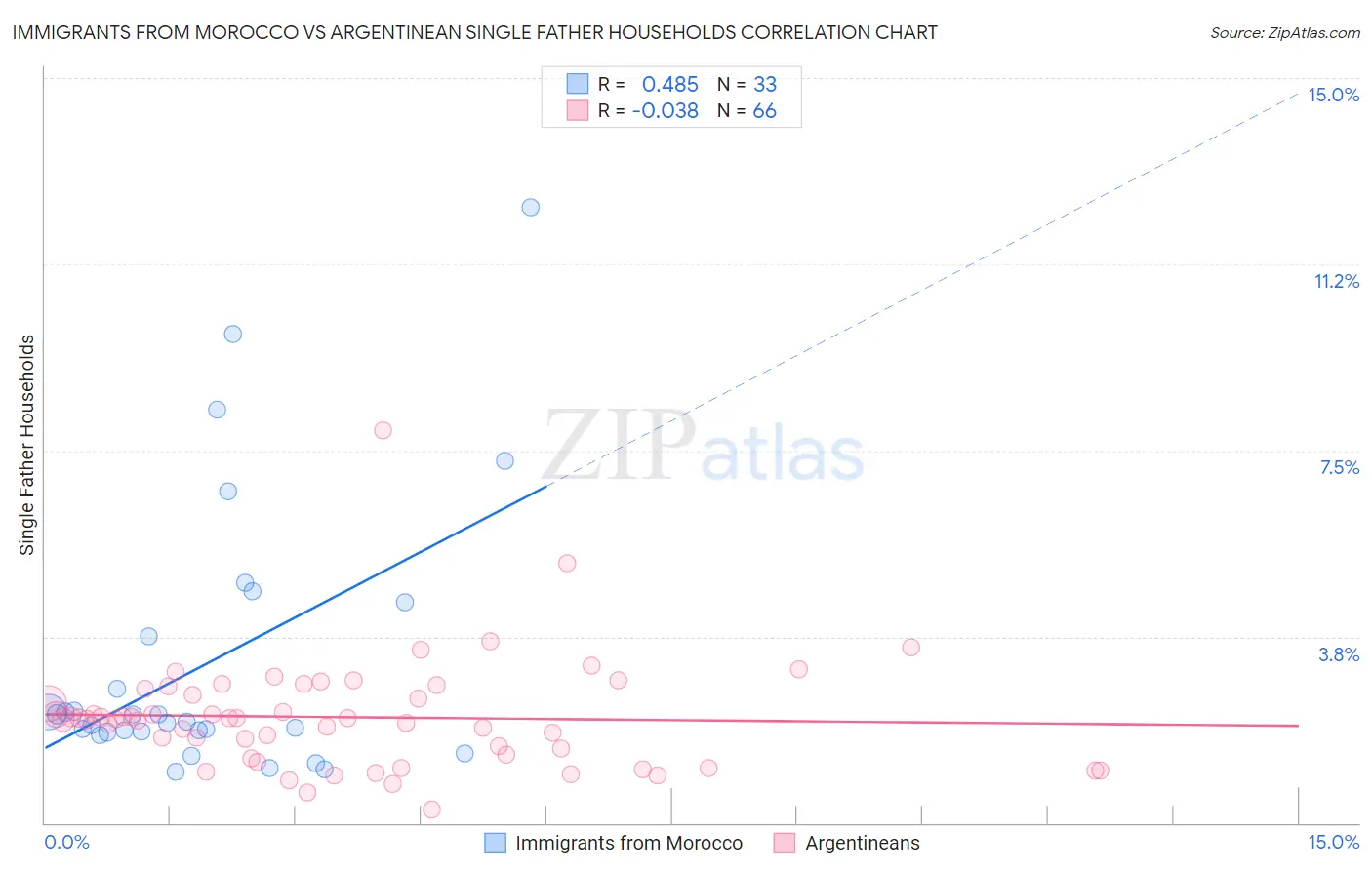Immigrants from Morocco vs Argentinean Single Father Households
COMPARE
Immigrants from Morocco
Argentinean
Single Father Households
Single Father Households Comparison
Immigrants from Morocco
Argentineans
2.2%
SINGLE FATHER HOUSEHOLDS
97.8/ 100
METRIC RATING
118th/ 347
METRIC RANK
2.1%
SINGLE FATHER HOUSEHOLDS
98.9/ 100
METRIC RATING
102nd/ 347
METRIC RANK
Immigrants from Morocco vs Argentinean Single Father Households Correlation Chart
The statistical analysis conducted on geographies consisting of 178,475,316 people shows a moderate positive correlation between the proportion of Immigrants from Morocco and percentage of single father households in the United States with a correlation coefficient (R) of 0.485 and weighted average of 2.2%. Similarly, the statistical analysis conducted on geographies consisting of 295,652,417 people shows no correlation between the proportion of Argentineans and percentage of single father households in the United States with a correlation coefficient (R) of -0.038 and weighted average of 2.1%, a difference of 1.3%.

Single Father Households Correlation Summary
| Measurement | Immigrants from Morocco | Argentinean |
| Minimum | 1.0% | 0.26% |
| Maximum | 12.4% | 7.9% |
| Range | 11.4% | 7.6% |
| Mean | 3.2% | 2.1% |
| Median | 2.0% | 2.1% |
| Interquartile 25% (IQ1) | 1.8% | 1.4% |
| Interquartile 75% (IQ3) | 4.1% | 2.7% |
| Interquartile Range (IQR) | 2.3% | 1.3% |
| Standard Deviation (Sample) | 2.7% | 1.1% |
| Standard Deviation (Population) | 2.7% | 1.1% |
Demographics Similar to Immigrants from Morocco and Argentineans by Single Father Households
In terms of single father households, the demographic groups most similar to Immigrants from Morocco are Trinidadian and Tobagonian (2.2%, a difference of 0.060%), Australian (2.2%, a difference of 0.090%), Hungarian (2.2%, a difference of 0.10%), Immigrants from Argentina (2.2%, a difference of 0.29%), and Immigrants from Barbados (2.2%, a difference of 0.32%). Similarly, the demographic groups most similar to Argentineans are Lebanese (2.1%, a difference of 0.020%), Immigrants from Western Europe (2.1%, a difference of 0.030%), Alsatian (2.1%, a difference of 0.040%), Immigrants from Northern Africa (2.1%, a difference of 0.18%), and Palestinian (2.2%, a difference of 0.41%).
| Demographics | Rating | Rank | Single Father Households |
| Immigrants | Northern Africa | 99.0 /100 | #100 | Exceptional 2.1% |
| Immigrants | Western Europe | 98.9 /100 | #101 | Exceptional 2.1% |
| Argentineans | 98.9 /100 | #102 | Exceptional 2.1% |
| Lebanese | 98.9 /100 | #103 | Exceptional 2.1% |
| Alsatians | 98.9 /100 | #104 | Exceptional 2.1% |
| Palestinians | 98.6 /100 | #105 | Exceptional 2.2% |
| Immigrants | Southern Europe | 98.6 /100 | #106 | Exceptional 2.2% |
| Slovenes | 98.5 /100 | #107 | Exceptional 2.2% |
| Immigrants | Netherlands | 98.5 /100 | #108 | Exceptional 2.2% |
| Barbadians | 98.4 /100 | #109 | Exceptional 2.2% |
| Italians | 98.3 /100 | #110 | Exceptional 2.2% |
| Immigrants | Canada | 98.3 /100 | #111 | Exceptional 2.2% |
| Immigrants | Trinidad and Tobago | 98.2 /100 | #112 | Exceptional 2.2% |
| Iraqis | 98.2 /100 | #113 | Exceptional 2.2% |
| Immigrants | North America | 98.2 /100 | #114 | Exceptional 2.2% |
| Immigrants | Barbados | 98.2 /100 | #115 | Exceptional 2.2% |
| Immigrants | Argentina | 98.1 /100 | #116 | Exceptional 2.2% |
| Hungarians | 97.9 /100 | #117 | Exceptional 2.2% |
| Immigrants | Morocco | 97.8 /100 | #118 | Exceptional 2.2% |
| Trinidadians and Tobagonians | 97.8 /100 | #119 | Exceptional 2.2% |
| Australians | 97.7 /100 | #120 | Exceptional 2.2% |